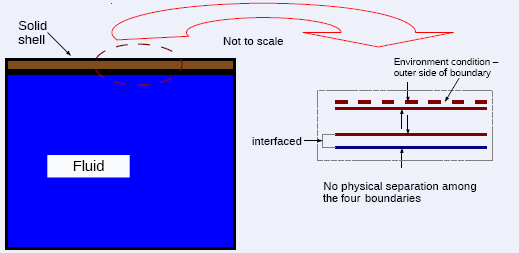Radiation
The Radiation Model is the gateway, or entry point to all of the radiation modeling capabilities of Simcenter STAR-CCM+. This section describes Simcenter STAR-CCM+’s radiation modeling.
To solve a radiation problem:
- Select the Radiation model.
- Select one of the radiative transfer models.
- Select one of the radiation spectrum models.
Reference information is provided for field functions that the radiation models use.
Radiative Transfer Models
The radiative transfer model defines the overall solution method for the governing Radiative Transfer Equation (RTE). Simcenter STAR-CCM+ provides two types of radiation transfer modeling:
- Surface Radiation Exchange
- Surface radiation exchange simulations
concern only the radiating and absorbing surfaces, not any intervening
medium. At these surfaces, external collimated radiation sources can be
specified such as laser beams. The following models are available:
- Surface-to-Surface Radiation (S2S)—A deterministic model that uses view factors (computed beforehand) to compute radiative exchange between surfaces. The view factor calculation is computationally expensive, but it needs to be done only once at the beginning of the simulation (assuming a static geometry), and only a system of linear equations needs to be solved afterward at every iteration. This procedure is computationally efficient and thus preferred for a large number of applications. Note that the accuracy of the S2S model is dependent on the number of rays used in the view factor computations.
- Surface Photon Monte Carlo (SPMC)—A statistical model that solves for the RTE via ray tracing. The SPMC model can incorporate complex configurations and radiative properties, and can provide highly accurate solutions of benchmark quality if an adequate number of photon bundles are used in the simulation. This model also allows for refraction, which is not available in the S2S model. For combined-mode heat transfer analysis, the RTE solution is normally required often (if not at every iteration), and the ray-tracing requirements involved can make SPMC computationally expensive.
- Volumetric Radiation Exchange
- Volumetric radiation exchange, also called
participating media radiation, passes through media that can absorb, emit,
or scatter thermal radiation. These media can include particles belonging to
a Lagrangian phase, using the Particle Radiation model, or particles such as
soot, using the soot emission models. The following models are available:
- Participating Media Radiation (DOM), using the Discrete Ordinates Method—The main parameter of the model is the accuracy of the angular representation of space around a given cell. The order of the ordinate set specifies this accuracy.
- Participating Media (Spherical Harmonics)—The model represents the radiation intensity gradient in the medium in terms of spherical harmonic functions. The main solver parameter specifies which function.
- Volumetric Photon Monte Carlo (VPMC)—The model provides a higher-fidelity alternative to the existing PDE-based, deterministic radiation models (DOM and Spherical Harmonics). This model also allows for combined volumetric/surface radiation modeling wherein some of the regions are participating while the other regions have surface-to-surface radiation enabled; radiative energy can seamlessly travel between these regions.
Radiation Spectrum Models
The radiation spectrum model defines how the radiation wavelength spectrum is considered (and potentially discretized) within the context of the transfer model. The radiation spectrum models are:
- Gray Thermal Radiation for modeling wavelength-independent radiation properties.
- Multiband Thermal Radiation for modeling wavelength-dependent radiation properties.
- k-Distribution Thermal Radiation for modeling in combustion simulations.
For the Gray Thermal spectrum model, the full thermal wavelength domain is considered as a whole, and all radiative properties are considered invariant within this single spectrum.
For the Multiband Thermal spectrum model, the full-thermal spectrum can be divided into subspectra or spectral bands. For each subspectrum, waveband-specific properties can be defined. During the radiation solution process, the transfer model is applied to each subspectrum. The total radiative transfer is the sum of the resulting solutions from the individual subspectra.
For the k-Distribution spectrum model, used with Participating Media Radiation (DOM or Spherical Harmonics), the spectrum is reordered into a monotonically increasing function of absorbtion coefficient with respect to fraction of the spectrum considered.For the surface radiation exchange models, S2S and SPMC, solar loads can additionally be considered with both the Gray and Multiband Thermal spectrum models by selecting the optional Solar Loads model.
The Surface-to-Surface model (S2S) also requires view factors. These view factors are calculated using the View Factors model.Radiation with Shell Regions
The model of radiation with solid shells is consistent with the general approach to radiation in solids, and is compatible with solar radiation, and with gray and multi-band radiation modeling. Each shell boundary has individually specified radiative properties (emissivity, reflectivity, transmissivity, and specularity).
The example given in the following figure shows a shell bounding a fluid, such as a thin-walled pipe containing liquid, applicable to engine and heating simulations. A shell can also stand alone, without containing fluid, for example as a mirror in a lighting simulation.
